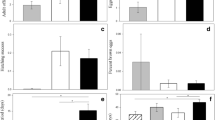Abstract
The postcopulatory behavior of Drosophila biarmipes and Drosophila melanogaster females was analyzed and compared. Females from both species were shown to undergo a series of behavioral changes following mating, including significant reductions in both sexual attractiveness and receptivity. However, while both attractiveness and receptivity returned to “virgin-like” levels within a few days in D. melanogaster, D. biarmipes females, which regained their sexual attractiveness within a few days, remained unreceptive to copulation for at least 2 weeks. With respect to fecundity, D. melanogaster females produced more offspring when given opportunities to remate, while D. biarmipes females did not benefit from remating opportunities. These observations suggest that D. biarmipes females may have the ability to store sperm and produce offspring from a single mating over longer periods of time than other drosophilids.
Similar content being viewed by others
REFERENCES
Antony, C., and Jallon, J.-M. (1982). The chemical basis for sex recognition in Drosophila melanogaster. J. Insect Physiol. 28: 873–880.
Antony, C., Davis, T. L., Carlson, D. A., Pechine, J.-M., and Jallon, J.-M. (1985). Compared behavioral responses of male Drosophila melanogaster (Canton-S) to natural and synthetic aphrodisiacs. J. Chem. Ecol. 11: 1617–1629.
Bastock, M., and Manning, A. (1955). The courtship of Drosophila melanogaster. Behaviour 8: 85–111.
Bubis, J., DeGreen, H. P., Unsell, J. L., and Tompkins, L. (1998). Temporal manipulation of ejaculate components by newly fertilised Drosophila melanogaster females. Animal Behaviour in press.
Chapman, T., Liddle, L. F., Kalb, J. M., Wolfner, M. F., and Partridge, L. (1995). Cost of mating in Drosophila melanogaster females is mediated by male accessory gland products. Nature 373: 241–244.
Chen, P. S. (1991). Biochemistry and molecular regulation of the male accessory gland secretions in Drosophila (Diptera). Ann. Soc. Entomol. Fr. 27: 231–244.
Davey, K. G. (1958). The migration of spermatozoa in the female of Rhodnius prolixus Stal. J. Exp. Biol. 35: 694–701.
Davey, K. G., and Webster, G. F. (1967). The structure and secretion of the spermatheca of Rhodnius prolixus Stal: A histological study. Can. J. Zool. 45: 653–657.
Fox, A. S. (1956). Chromatographic differences between males and females in Drosophila melanogaster and the role of X and Y chromosomes. Physiol. Zool. 29: 28–298.
Frank, J. C., Adams, C., and McRobert, S. P. (1995). Sucrose density separation of Drosophila larvae from instant media. Dros. Info. Serv. 76: 172.
Gromko, M. H., and Pyle, D. W. (1978). Sperm competition, male fitness and repeated mating by female Drosophila melanogaster. Evolution 32: 588–593.
Gromko, M. H., Newport, M. E. A., and Kortier, M. G. (1984). Sperm dependence of female receptivity to remating in Drosophila melanogaster. Evolution 38: 1273–1282.
Kubli, E. (1992). The sex-peptide. BioEssays 14: 779–784.
Lindsley, D., and Grell, E. (1968). Genetic variations of Drosophila melanogaster. Carnegie Inst. Publ. 627.
Malloch, J. R. (1924). Two Drosophilidae from Coimbatore. Mem. Dept. Agr. India Entomol. Ser. 8: 63–65.
Mane, S. D., Tompkins, L., and Richmond, R. C. (1983). Male esterase 6 catalyzes the synthesis of a sex pheromone in Drosophila melanogaster females. Science 222: 419–422.
Manning, A. (1967). The control of female receptivity in female Drosophila. Anim. Behav. 15: 239–250.
McRobert, S. P., and Jackson, L. L. (1988). Description of sexual behaviors of Drosophila rajasekari. J. Chem. Ecol. 15: 1423–1432.
Scott, D. (1986). Sexual mimicry regulates the attractiveness of mated Drosophila melanogaster females. Proc. Natl. Acad. Sci. USA 83: 8429–8433.
Sreerama Reddy, G., and Krishna Murty, N. B. (1968). Drosophila rajasekari, a new species from Mysore (India). Proc. Indian Acad. Sci. 68B: 202–205.
Tompkins, L. (1984). Genetic analysis of sex appeal in Drosophila. Behav. Genet. 14: 411–440.
Tompkins, L., and Hall, J. C. (1981). The different effects on courtship of volatile compounds from mated and virgin Drosophila females. J. Insect Physiol. 27: 17–21.
Tompkins, L., Hall, J. C., and Hall, L. (1980). Courtship-stimulating volatile compounds from normal and mutant Drosophila. J. Insect Physiol. 26: 689–697.
Wheeler, M. R. (1981). The Drosophilidae: A taxonomic overview. In The Genetics and Biology of Drosophila, Vol. 3a, Academic Press, London.
Author information
Authors and Affiliations
Corresponding author
Rights and permissions
About this article
Cite this article
McRobert, S.P., Adams, C.R., Wuttke, M. et al. A Comparison of Female Postcopulatory Behavior in Drosophila melanogaster and Drosophila biarmipes . Journal of Insect Behavior 10, 761–770 (1997). https://doi.org/10.1023/B:JOIR.0000010411.79386.22
Issue Date:
DOI: https://doi.org/10.1023/B:JOIR.0000010411.79386.22




